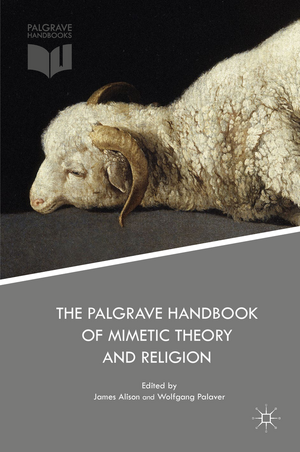The Palgrave Handbook of Mimetic Theory and Religion
Editat de James Alison, Wolfgang Palaveren Limba Engleză Hardback – 20 oct 2017
Preț: 2144.71 lei
Preț vechi: 2615.50 lei
-18% Nou
Puncte Express: 3217
Preț estimativ în valută:
410.39€ • 447.18$ • 345.81£
410.39€ • 447.18$ • 345.81£
Carte tipărită la comandă
Livrare economică 23 aprilie-07 mai
Preluare comenzi: 021 569.72.76
Specificații
ISBN-13: 9781137552808
ISBN-10: 1137552808
Pagini: 700
Ilustrații: XXVII, 549 p.
Dimensiuni: 155 x 235 x 40 mm
Greutate: 9.87 kg
Ediția:1st ed. 2017
Editura: Palgrave Macmillan US
Colecția Palgrave Macmillan
Locul publicării:New York, United States
ISBN-10: 1137552808
Pagini: 700
Ilustrații: XXVII, 549 p.
Dimensiuni: 155 x 235 x 40 mm
Greutate: 9.87 kg
Ediția:1st ed. 2017
Editura: Palgrave Macmillan US
Colecția Palgrave Macmillan
Locul publicării:New York, United States
Cuprins
Part I .VIOLENT ORIGINS.- 1. Introduction.-2. An Essay on Hominization: Current Theories, Girardian-Darwinian Approaches.- 3. The Emergence of Human Consciousness in a Religious Context.- 4. Freud, Moses and Monotheism, and the Conversation between Mimetic Theory and Psychoanalysis.- 5. Kristeva and the Question of Origins.- 6. Girard and Burkert: Hunting, Homo Necans, Guilt.- 7.Vengeance and the Gift.- 8. Mesoamerican Civilizations and Sacrifice.- 9. Çatalhöyük, Archaeology, Violence.- Part II. FROM RITES TO WRITING.- 10. Introduction.- 11. Lévi-Strauss and Girard on Myth and Ritual.- 12. The Axial Moment and Its Critics: Jaspers, Bellah, and Voegelin.- 13. Monotheism and the Abrahamic Revolution: Moving Out of the Archaic Sacred.- 14. The Eastern Revolution: From the Vedas to Buddhism, Jainism, and the Upanishads.- 15.The Classical World: Sacrifice, Philosophy, and Religion.- 16. The Transition from Orality to Writing: Mimetic Theory and Religion.- 17. Biblical Interpretation: Old and New Testaments, a New Hermeneutic(s)?.- 18. Theological Inversions: Raymund Schwager, Robert G. Hamerton-Kelly, and James G. Williams.- 19. Oedipus and Greek Tragedy.- 20. Nietzsche, Dionysos, and the Crucified.- Part III. THEOLOGICAL ANTHROPOLOGY.- 21. Introduction.- 22. An Epistemology of Revelation.- 23. Approaches to Atonement: How Girard Changes the Debate.- 24. Original Sin, Positive Mimesis.- 25. Embodiment and Incarnation.- 26. Eucharist and Sacrifice: the Transformation of the Meaning of Sacrifice through Revelation.- 27. Girard and Augustine.- 28. Raymund Schwager: Dramatic Theology.- 29. American Protestant Reception of Mimetic Theory: 1986-2015.- 30. James Alison’s Theological Appropriation of Girard.- 31. Levinas and the Prophetic Current.- 32. Mysticism, Girard, and Simone Weil.- 33. From the Sacred to the Holy in the World’s Religions: Judaism, Christianity, Islam, Hinduism, Buddhism.- Part IV. SECULARIZATION AND MODERNITY.- 34. Introduction.- 35. Secularization.- 36. The Barren Sacrifice.- 37.The Economy as the Opium of the People.- 38. “The Carnal Mind Rebels”: Christianity and the Witch Hunt.- 39. Mimetic Theory, Religion, and Literature as Secular Scripture.- 40. The Development of the Self.- 41. Modern Pathologies and the Displacement of the Sacred.- 42. Ressentiment and the Turn to the Victim: Nietzsche, Weber, Scheler.- 43. René Girard and Charles Taylor: Complementary Engagements with the Crisis of Modernity.- 44. Secularization Revisited: Tocqueville, Asad, Bonhoeffer, Habermas.- Part V. APOCALYPSE, POST-MODERNITY, AND THE RETURN OF RELIGION.- 45. Introduction.- 46. The Return of Religion.- 47. Mimetic Theory And The Katēchon.- 48. Hӧlderlin and Heidegger: Which God Will Save Us?.- 49.“The Apocalypse Has Begun”: Ivan Illich and René Girard on Anti-Christ.- 50. Weak Faith.- 51. Terrorism and Religion.- 52. Apocalypse: Hope Against All Hope.- 53. Enlightened Doomsaying.- Part VI. ALTERNATIVE PARADIGMS.- 54. Introduction.- 55. The New Atheism: Dawkins, Harris, Hitchens.- 56. Scientific Evidence for the Foundational Role of Psychological Mimesis.- 57. Cognitive Neuroscience and Religion.- 58. Generative Anthropology.- 59. Critiques of Girard’s Mimetic Theory.- 60. A Theory of Everything? A Methodological Tale.- 61.Mimetic Theory and Self-Criticism.- Part VII. APPROACHING THE CONTEMPORARY.- 62. Introduction.- 63. Scandal.- 64.Terrorism and the Escalation of Violence.- 65. Religious Conflicts in the Contemporary World.- 66. Modern Confessional Movements.- 67. Mimetic Insights into the Sacred in Film.- 68. Resurgent Religious Themes in Contemporary Film.- 69. Pastoral Outreach and Community Living.
Notă biografică
James Alison, priest, theologian, and author, is a Fellow of Imitatio. He has been working with Girard’s thought since 1985 and has contributed to the field with a number of books, most recently the adult catechetical course “Jesus the Forgiving Victim.”
Wolfgang Palaver is Professor of Catholic Social Thought at the University of Innsbruck. From 2007 to 2011 he was president of the Colloquium on Violence and Religion. Recent publications: René Girard's Mimetic Theory (2013); The European Wars of Religion (2016).
Wolfgang Palaver is Professor of Catholic Social Thought at the University of Innsbruck. From 2007 to 2011 he was president of the Colloquium on Violence and Religion. Recent publications: René Girard's Mimetic Theory (2013); The European Wars of Religion (2016).
Textul de pe ultima copertă
The Palgrave Handbook of Mimetic Theory and Religion draws on the expertise of leading scholars and thinkers to explore the violent origins of culture, the meaning of ritual, and the conjunction of theology and anthropology, as well as secularization, science, and terrorism. Authors assess the contributions of René Girard’s mimetic theory to our understanding of sacrifice, ancient tragedy, and post-modernity, and apply its insights to religious cinema and the global economy. This handbook serves as introduction and guide to a theory of religion and human behavior that has established itself as fertile terrain for scholarly research and intellectual reflection.
Caracteristici
The first introductory volume to gather articles from the world’s foremost scholars of mimetic theory and religion, and first major collective work of this scope on mimetic theory Makes a decisive contribution to the reassessment of our understanding of religion in the 21st century Shows the importance and relevance of mimetic theory to contemporary scholarly debates in theology, religious studies, anthropology, and philosophy, among other fields Includes supplementary material: sn.pub/extras
